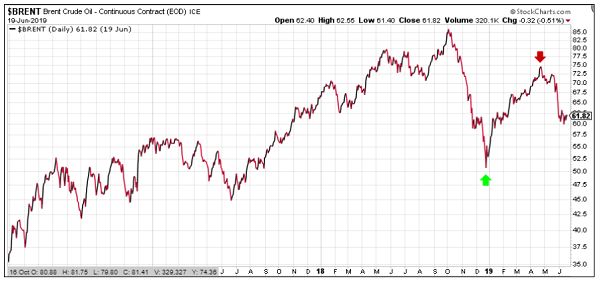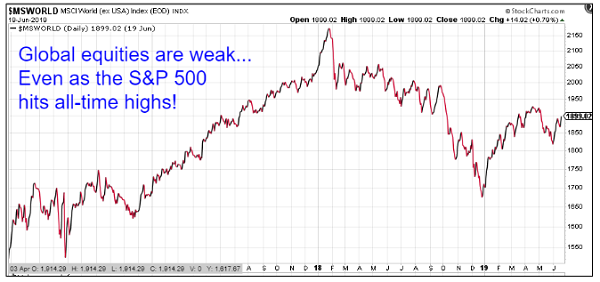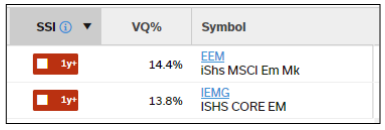Should you invest in emerging market equities? Numerous research houses say yes. Some money managers have favored the emerging market growth story for many years, on the grounds that emerging market equities have a better long-term growth story and less of a valuation premium than U.S. equities.
But the valuation gap in favor of U.S. equities is there for a reason — and in terms of whether or not to invest in emerging markets right now, crude oil is saying “no.” The remarkable weakness in the crude oil price is a bearish sign for emerging markets and global growth.
When you factor in the bearish crude oil signal on top of other emerging market warning signs — like the fallout implications of trade war and the drastic underperformance of emerging market equities relative to U.S. equities — the combined picture merits standing aside, or possibly even going short.
Crude oil is still, by far, the most important commodity in the world. That will change one day, but the necessary combination of 21st century battery technology and renewable energy scale-up is not there yet.
Because the global economy still runs on oil, the oil price is a signaling device for global growth. When growth expectations are bullish, crude oil tends to trend higher. There is a basic logic to this: Most of the world’s future growth is in developing world countries. The better the growth outlook, the more oil they will use, as billions of consumers move toward Western consumption habits.
This is also why, when the oil price is weak, it functions as a global growth warning sign. If crude oil is in a slump, it suggests the long-term global demand outlook is poor. A sharp turn in the crude oil price is thus a kind of sentiment signal.
If oil is trending higher, and then takes a harsh turn for the worse, that suggests the growth outlook has turned too, or has otherwise weakened significantly. That is just what’s happened in recent months. Right now, the price of crude oil is notably weak.
We can see this in the price action of Brent crude, the more global of the two major crude oil benchmarks. (West Texas Intermediate crude, the other benchmark, is more driven by the domestic U.S. economy — though WTI crude is also weak.) The Brent crude oil chart, shown below, tells a story of twists and turns in the global growth outlook.
 |
In late 2018, the markets had a bad scare. Then 180-degree dovish U-turn from the Federal Reserve then created a v-bottom and a new uptrend, which is still ongoing for the major U.S. indexes. But starting in April, the picture for crude oil and emerging markets turned dark again.
Crude oil’s sharp turn lower corresponds to a ramping up of trade war fears. China is a major source of global growth, and emerging markets in general are highly sensitive to tariffs, which makes long-term trade war fallout a significant threat. Countries like the United States have a strong domestic economy to fall back on, whereas most emerging market economies don’t.
It’s surprising, in general, how badly global equities have underperformed relative to U.S. equities. The chart below, the MSCI World ex-USA index, shows how global equities look when you take the U.S. out of the equation. For reasons that could persist, the picture outside the U.S. still looks bleak — even as the S&P 500 hits new all-time highs.
 |
Another point of concern is crude oil’s lack of response to what is happening in the Middle East.
Crude oil has historically been subject to “supply shocks,” where the threat of lost supply causes the crude oil price to surge. That’s because there are no real substitutes for oil — at least not yet at the massive volumes required.
This means that, when a significant portion of crude oil supply goes offline, the price tends to shoot higher. The stronger the demand signal, the more sensitive the oil price becomes to any supply threat.
One of the biggest threats imaginable to crude oil supply is full-blown Middle East conflict. In a real conflict, millions of barrels per day would be removed from the market. That makes the Strait of Hormuz, a narrow waterway between the Persian Gulf and the Gulf of Oman, one of the most geopolitically sensitive transport channels in the world.
What’s remarkable about this is how, in terms of the recent crude oil price, the odds of a potential Middle East conflict have skyrocketed, and yet the oil price hasn’t truly responded.
Under more normal circumstances, recent events would have been wildly bullish for oil prices, leading to a major spike via supply shock concerns. Tanker attacks in the Gulf of Oman, coupled with a thousand U.S. troops being sent to the region as Iran shoots down a U.S. drone, would be expected to add $20 to $30 per barrel to the oil price, if not more.
And yet, this time, the price of oil has barely responded to the looming threat of a U.S.-Iran conflict. It is showing some upward movement as of this writing, but nothing like normal expectations. This further suggests the demand signal for crude oil is weak — which bodes ill for emerging markets.
 |
The two most liquid emerging market ETFs by volume are the iShares MSCI emerging markets ETF (EEM) and the iShares core emerging markets ETF (IEMG).
These and other emerging market ETFs have seen a boost in recent days on renewed hopes of a U.S.-China trade deal — but if hopes fall through after the upcoming G20 meeting, these ETFs could fall right back again. Meanwhile crude oil is warning us to stay away.
Below, you can see our latest composite cycle forecast for crude oil. We’re expecting a market bottom between September and December of this year with the possibility for growth running through July 2020.
 |
For an idea of our how previous cycle models have performed for crude oil, you can review this article we posted last July.
This further strengthens our bearish views on crude oil for the remainder of the year.





